Living fit and active
Being physically active has many physical, social, and emotional benefits and can lead to a reduced incidence of chronic diseases. Participation in regular physical activity contributes to better fitness level and overall wellness.
Physical activity
It is defined as any bodily movement that is produced by the contraction of muscles and substantially increases energy expenditure. Examples of physical activities are walking, jogging, cycling, playing games, lifting weight, doing house chores etc.
Physical fitness
Physical fitness is defined as a set of attributes that people have or achieve that relates to the ability to perform physical activity It can be categorised into :
- Health-related fitness
- Skill-related fitness
For a non-athlete we should be developing health related fitness components to improve our health.
Health-related fitness components include :
- Cardiovascular endurance / aerobic capacity Ketahanan
- the ability of the heart muscle to function efficiently to enable us to work for relatively long periods of time without becoming overtired.
- Muscular endurance
- the ability of a muscle group to execute repeated contractions over a period of time sufficient to cause muscular fatigue. (Push up)
- Muscular strength
- the maximal force that can be generated by a specific muscle or muscle group
- Flexibility
- the ability to move our joints through their full range of movement.
- Body composition
- refers to the relative percentage of body weight that is fat and fat free tissue.
Components of skill-related fitness fare much associated with sports skills.
The components of skill-related fitness include :
- Power
- our ability to contract muscle with speed and force in one explosive act.
- Agility
- our ability to change the direction of the body at a greate speed.
- Coordination
- our ability to perform complex movement with ease. Speed
- Speed
- our ability to move all or part of our body as quickly as possible.
- Balance
- our ability to retain balance when stationary or moving.
- Reaction time
- our ability to react to a stimulus quickly.
Benefits of regular physical activities
- Reduces your risk of heart disease, high blood pressure, osteoporosis, diabetes, cancer and obesity.
- Keeps joints, tendons and ligaments flexible so it’s easier to move around.
- Strenghten bone and muscle.
- Improve your ability to do daily activities and prevent fall, if you are an older adult.
- Reduces some of the effects of aging.
- Helps relieve stress and anxiety.
- Improve mental health and mood.
- Increase your energy and endurance.
- Helps you sleep better.
- Lose weight.
- Helps us to control body weight and prevents obesity.
Fitness program
Gradual exercise will be good for you. It is advisable for you to consult a doctor if you haven’t been active (sedentary individual), have any health problem, you are pregnant or above 40 years old. There are 1,440 minute in every day. Generally we should schedule at least 30 minutes of some sort of physical activity every day. Add up your activities in periods of at least 10 minutes each. Start slowly and build up. Examples :
- Playing with children
- Gardening
- Take the stairs instead of elevator
- Go for a walk during your coffee break or lunch
- Walk all or part of the way to work
- Do housework at a fast pace
- Rake leaves or do other yards work
- Start with a 10 minute walk and gradually increase the time.
After achieving 30 minutes of moderate activity in most days of a week, then plan three or four aerobic activities per week at about 50% – 85% of maximal heart rate (target heart rate) for 30 -40 minutes session. Each session should begin with warm up and end with cooling down. It is important to progress from light to more intense physical activity sessions. Set up a progression from walking to jogging to running to games.
Aerobic Exercise
Aerobic exercise is defined as any activity that uses large muscle group and can be maintained continously . Examples include walking, jogging, swimming, cycling etc. These activities cause you to breathe more deeply and your heart to work harder to pump blood. It improves the health of your heart and lung.
Target heart rate
The safe range of heart beat per minute during exercise and the threshold needed to achieve the training effect. Follow the chart that shows the target heart rate for people of different age.
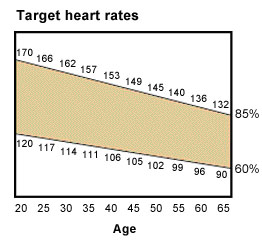
For a beginner start with the lower target heart rate (60%) and as your fitness improves, you can do harder physical activities to reach the target heart rate up to the upper level (85%). For example, if your age is 45 years old your target heart rate will be 105 – 149 beats per minute. How to measure heart rate?
- Heart Rate can be measured by palpating the radial artery.
- The radial artery is at the lateral aspect of the palm side of the wrist, in line with the base of the thumb.
- Use the tip of the middle and index fingers. Count the first beat as zero as the stopwatch starts.
- Count the beat for 15 seconds and then multiply by four for beats per minute.
- Monitor heart rate within five seconds after exercise ends.
- If your pulse is below your target rate, continue to exercise a little harder and retake your pulse later.
Equipment : Stopwatch
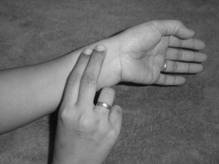
Click here to evaluate your health risk!!! Components of a Complete Physical Activity Program
- Muscular Fitness PhaseAfter completing the aerobic phase, you should slow down your activities to bring your heart rate down gradually. You should incorporate some strengthening activities particularly in developing muscular strength and enduranceExamples of strengthening activities :
- Push-ups
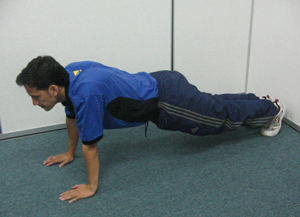
Standard position
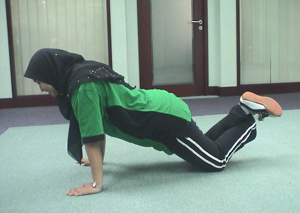
Modification Position
- ‘Curl-ups’
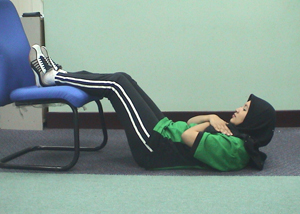 Abdominal crunch (legs on a chair)
Abdominal crunch (legs on a chair) - Cool-down PhaseThe purpose of cool-down phase is to slowly decrease the pulse rate and to lower the body temperature. Light activities similar to the warm-up phase are repeated during the cool-down. It is suggested that beginners should do more stretching exercises at this time because it has the advantage of allowing one to stretch warm muscles that have been contracting forcibly during the aerobic phase.
Stretching exercise
Static stretching exercises can improve your flexibility.
- Stretches are held to the point of mild tension, not pain.
- Hold a static stretch for 10 to 30 seconds and relax.
- Breathe normally during each stretching exercise. Do not hold your breath.
- Do each exercise slowly.
Static Stretching Exercises
- Neck stretches
- Push-ups
|
|
|
|
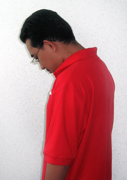 |
|
|
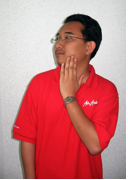 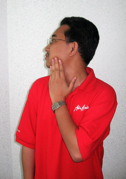 |
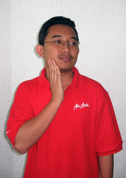  |
|
Pull arm behind the head
|
 |
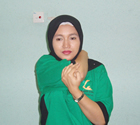 |
Push arm over shoulder
|
Lateral body stretch
|
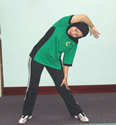 |
 |
Trunk rotation
|
Sitting toe touch
|
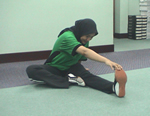 |
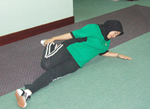 |
Leg Pull
|
Butterfly
|
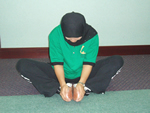 |
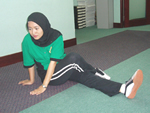 |
Leg cross back stretch
|
Back stretching exercise
|
 |
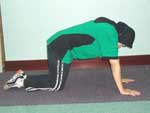 |
|
Forward lunge
|
 |
 |
Calf Stretch
|
| Last Reviewed | : | 10 Mei 2012 |
| Writer | : | Dr. Amirullah b. Mohd Arshad |
| : | Hamidah Ishak | |
| Reviewer | : | Wong Swee Fong |







